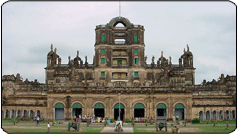Constantia - La Martiniere
The relationship between the French entrepreneur Claude Martin and Nawab Asaf-ud-Daulah gained for the city of Lucknow a reputation and position of significance for its architecture that is unparalleled. The city which was quite unknown and under-developed, suddenly shot into limelight for its grand buildings like the Asafi Imambara and Rumi Gate built by the Nawab and for the European style of buildings that started appearing at the outskirts of the city which were mostly designed and constructed by Claude Martin. However, as fate would have it, one such building, even before its construction, proved a 'bone of contention' between the two great personalities of their time.
The building in dispute was the 'Mansion of Constantia', which Martin planned to build on the banks of the river Gomti, at the extreme eastern end of the city, at a place called lakhpeda for one lakh trees said to be planted there. When Martin divulged his plans to the Nawab, he was so fascinated with it that he offered one lakh ashrafi (gold coins) for it. It was just a chance that the Nawab failed to fortify the offer with an advance and the mansion remained the property of Claude Martin.
The Nawab pressed for its possession on several occasions having been obsessed by it. Meanwhiie, Martin also had second thoughts on the idea of selling the building when he intended to make it the 'finale' of his architectural exploits. His buildings were indeed exploits because of typical innovations that were done by Martin in their design and construction. Major General Claude Martin fearing the forcible take-over of Constantia by the Nawab or his descendants designed an underground vault as a mausoleum for the burial of his mortal remains and made a specific Will for this purpose.
In his Will, he also made endowments for establishing three educational institutions for boys, at Lyons in France (his birth place), at Calcutta and at Lucknow, where it was to be established in the Constantia complex. Today this is the 'La Martiniere College' for boys, but its popular name and address still remains as Martin Saheb ki Kothi in Martin Purwa locality, beyond Banarsi Bagh.
The building which got its name from the motto of Claude Martin 'Lahore et Constantia' [inscribed on its exterior towards east] is a six storeyed building (including basement) and has an arrangement of four wells which were sunk 30 feet below the water level of the river. The wells culminate as octagonal towers at the top. They are also meant to cool the basement of the main building.
Constantia is a unique combination of a banquet hall, a mausoleum, a mansion, a palace and a fortress with intricate defence arrangements. One of its attractions is an Obelisk which was erected later. It is a 125 feet high majestic fluted column erected on low ground. It presents a beautiful sight when surrounded with water accumulated due to rains or the back flow of the river.
It is ironical that Europeans themselves did not find the Constantia in good taste. James Ferguson who is considered an authority on Eastern architecture calls the design 'somewhat fantastic in arrangement which sins against the rules of pure Palladian Art to an extent that would not be pardonable except in such climate and under the peculiar circumstances in which it was erected'. Similarly, John Pemble commenting about the Western influence on the Lucknow architecture refers to Constantia as a 'bizarre palace' and reflects that 'Martin's main concern in designing this palace seems to have been to incorporate as many different architectural motifs as he could remember and the result is a weird jumble of classic columns, arches, pediments and balustrades, with Gothic battlements, turrets and statues and heraldic lions'. However, thereafter in the next line, he admits its grandeur.
Even today, Constantia is undoubtedly one of the most spectacular European building and one that is quite well preserved. The La Martiniere College administration deserves accolades for their efforts in this direction and for keeping the Constantia in its original form as built in its first phase in 1800 and later in 1840 when additional sLctures were added (as were planned by Claude Martin).
Claude Martin must indeed be given due credit for utilising local talent in ail his constructions. He thus, dispelled the prevalent myth that anything out of the ordinary could only be built by the Europeans. In fact, he left emphatic instructions that after his death, Constantia should be completed by two of his faithful native servants, Mutchoo and Chhota Qadir, who were brothers and who according to Martin 'were well acquainted how and in what mode I carry these buildings, as well as in buying materials or in paying the workmen'.
Source:
Times of India, Heritage
Monday 4.7.1994 — The magnificent Constantia

